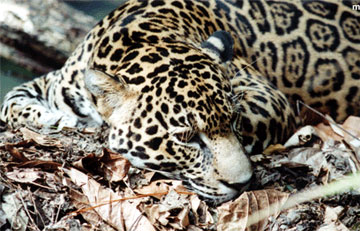Central America agrees to jaguar corridor
Central America agrees to jaguar corridor
May 23, 2006
Environment ministers from eight nations give green light to network of protected areas
A group of environment ministers representing the seven nations of Central America and Mexico have agreed to establish a network of protected areas and wildlife corridors to safeguard jaguar populations, according to the New York-based Wildlife Conservation Society. The decision was made at the Second Mesoamerica Protected Area Congress held in Panama earlier this month.
The decision came as a response to bolstering the already established Paseo Pantera—a network of protected areas and wildlife corridors first announced in 1990. That initiative, which became known as the Mesoamerica Biological Corridor, officially launched in 1997 with multi-national support at the highest levels of government and millions of dollars in financial commitments by GEF, the EU, and the World Bank. Its ambitious goal was to balance human needs, sustainable development, and the conservation of some of the earth’s greatest biodiversity, though many conservationists feel that its implementation has been slow and that the focus on biodiversity versus social issues is not in proper balance.
“Re-evaluating the already established network of parks and protected areas, while considering the protection of multi-use landscapes as wildlife corridors particularly for jaguars, breathes new life into safeguarding wildlife in Central America,” said Dr. Alan Rabinowitz, executive director of WCS’ Science and Exploration Program. “We commend these nations for agreeing to such a far-sighted initiative.”

Jaguar in Belize. Photo by Nancy Butler |
|
In a signed document promoting multilateral cooperation on environmental and social initiatives, the Ministers resolved to support and implement the jaguar corridor project. The Central American Commission of Environment and Development (CCAD), created by Heads of State in 1989 to promote and facilitate regional environmental activities, was instructed to coordinate with WCS in moving the jaguar corridor forward. During the next year, WCS field teams will be visiting and ground-truthing key sites of the proposed jaguar corridor on a country-by-country basis, then working with CCAD to ensure the incorporation of key sites into the Mesoamerica Biological Corridor.
As the largest cat in the Americas (and the third largest in the world after the tiger and the lion), the jaguar ranges from the Southwestern United States to Argentina, one of the most extensive distributions of any cat species. The fragmentation of habitat through human development is one of the biggest threats to jaguars, isolating populations and preventing genetic exchange between them. “All over the world, we’ve seen huge swaths of wilderness reduced to scattered islands in a flood of development,” added Rabinowitz. “Large predators within those islands then become highly endangered by both loss of habitat and genetic diversity. By working together, the countries of Central America can connect their wild lands and save their shared natural heritage—the jaguar.”
This is a modified news release from Wildlife Conservation Society













